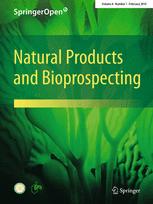|
|
Anti-cancer potential of South Asian plants
Collect
Mohammad Mijanur RAHMAN, Md. Asaduzzaman KHAN
Natural Products and Bioprospecting. 2013, 3 (3): 74-88.
DOI: 10.1007/s13659-013-0027-6
Phyto-chemicals are increasingly being used in the treatment of cancer because of their availability, potential anti-cancer activity with less adverse effects when compared with chemotherapy. The variation of climate and geography in South Asian countries provides a nursing environment for the growth of versatile plant species, that are repeatedly drawing attention of the scientific community. In this review, we have focused on the anti-cancer potential of thirty plants, which are commonly found in Bangladesh, India, Nepal, Pakistan and Sri Lanka, with their mechanisms of action. In particular, we have discussed the bio-active components that display anti-cancer activity, which have been identified in these plants. This review may help researchers to profile plants with known anti-cancer effect of this region and further investigations of anti-cancer agents in medicinal plants from South Asia.
References |
Related Articles |
Metrics
|
|
|
Dendrowardol C, a novel sesquiterpenoid from Dendrobium wardianum Warner
Collect
Wei-Wei FAN, Feng-Qing XU, Fa-Wu DONG, Xiao-Nian LI, Yan LI, Yu-Qing LIU, Jun ZHOU, Jiang-Miao HU
Natural Products and Bioprospecting. 2013, 3 (3): 89-92.
DOI: 10.1007/s13659-013-0024-9
Dendrowardol C (1)-a novel sesquiterpenoid, with an unprecedented 4/5/6/6 tetracyclic carbon backbone, together with two known cyclopacamphane-type sesquiterpenoids; dendronobilin I (2) and dendrobane A (3) were isolated from the stems of Dendrobium wardianum Warner. The structure of 1 was established on the basis of spectroscopic data and the absolute configuration was determined by single-crystal X-ray diffraction crystallography. The hypothetical biosynthetic pathway of 1 was postulated. Compound 1 showed no cytotoxic activity against human tumor cell lines HL-60, SMMC-7721, A-549, MCF-7, and SW480.
References |
Related Articles |
Metrics
|
|
|
New spinosin derivatives from the seeds of Ziziphus mauritiana
Collect
Bin WANG, Hong-Tao ZHU, Dong WANG, Chong-Ren YANG, Min XU, Ying-Jun ZHANG
Natural Products and Bioprospecting. 2013, 3 (3): 93-98.
DOI: 10.1007/s13659-013-0028-5
Three new acylated flavonoid C-glycosides, 6'''-(-)-phaseoylspinosin (1), 6'''-(3"",4"",5""-trimethoxyl)-(E)-cinnamoylspinosin (2), and 6'''-(4""-O-β-D-gluco-pyranosyl)-benzoylspinosin (3), were isolated from the seeds of Ziziphus mauritiana (Rhamnaceae). A further 19 known compounds including eight spinosin analogues (4-11) were also isolated. Their structures were elucidated by means of spectroscopic analysis and chemical method. Among spinosin derivatives 1, 2, 4, 7, 8, and triterpenoid saponin 14, jujuboside A (14) displayed moderate acetylcholinesterase (AchE) inhibitory activity with an inhibition value of 46.2% at a concentration of 1 μM.
References |
Related Articles |
Metrics
|
|
|
New jatropholane-type diterpenes from Jatropha curcas cv. Multiflorum CY Yang
Collect
Yuan-Feng YANG, Jie-Qing LIU, Lei SHI, Zhong-Rong LI, Ming-Hua QIU
Natural Products and Bioprospecting. 2013, 3 (3): 99-102.
DOI: 10.1007/s13659-013-0031-x
Three new jatropholane-type diterpenoids, jatropholones C-E (1-3), along with seven other known compounds, including sikkimenoid B (4), jatrophaldehyde (5), epi-jatrophaldehyde (6), epi-jatrophol (7), jatrophol (8), jatropholone A (9), and jatropholone B (10), were isolated from the roots of a natural cultivar of Jatropha curcas (J. curcas cv. Multiflorum CY Yang). The structural elucidations of 1-3 were accomplished by extensive NMR analysis. Compounds 4, 6, and 8 demonstrated inhibition activity against the microorganisms with the MIC values from 0.10 to 0.18 mg/mL.
References |
Related Articles |
Metrics
|
|
|
Three new physalins from Physalis alkekengi var. franchetii
Collect
Wan-Xuan XU, Jian-Chao CHEN, Jie-Qing LIU, Lin ZHOU, Yi-Fen WANG, Ming-Hua QIU
Natural Products and Bioprospecting. 2013, 3 (3): 103-106.
DOI: 10.1007/s13659-013-0021-z
Three new physalin steroids, physalin III (1), physalin IV (2), 3-O-methylphysalin X (3), together with five known physalins (4-8) were isolated from the 80% EtOH extract of calyces of Physalis alkekengi var. franchetii. The structures of the new compounds were revealed through 1D and 2D NMR and mass spectroscopic studies.
References |
Related Articles |
Metrics
|
|
|
ent-Kaurane diterpenoids from the plant Wedelia trilobata
Collect
Bing-Ji Ma, Chun-Nan Wen, Yuan Gao, Fu-Cai Ren, Fei Wang, Ji-Kai Liu
Natural Products and Bioprospecting. 2013, 3 (3): 107-111.
DOI: 10.1007/s13659-013-0029-4
Four new ent-kaurane diterpenoids, namely, 3α-tigloyloxypterokaurene L3 (1), ent-17-hydroxy-kaura-9(11),15-dien-19-oic acid (2), and wedelobatins A (3) and B (4), together with 11 known ent-kaurane diterpenoids (5-15), were isolated from the ethanol extract of Wedelia trilobata. All the structures of 1-15 were elucidated on the basis of spectroscopic studies.
References |
Related Articles |
Metrics
|
|
|
Chemical constituents from the aerial parts of Euphorbia sikkimensis and their bioactivities
Collect
Da-Song YANG, Wei-Bing PENG, Zi-Lei LI, Xue WANG, Jian-Guo WEI, Ke-Chun LIU, Yong-Ping YANG, Xiao-Li LI
Natural Products and Bioprospecting. 2013, 3 (3): 112-116.
DOI: 10.1007/s13659-013-0006-y
Phytochemical investigation of the aerial parts of Euphorbia sikkimensis led to the isolation of one new diterpenoids, named sikkimenoid E (1), together with thirteen other known compounds (2-14). Their structures were established by means of spectroscopic methods. Compound 2 was identified to be a trinortriterpenoid, and derived for the first time from a natural source. In this paper we reveal for the first time its comprehensive spectral data and NMR spectral assignment. Compound 4 showed antiangiogenic activity with an IC50 value of 5.66 μM in a zebrafish model, and compounds 5 and 6 exhibited cytotoxicity toward A549 cell line with IC50 values of 12.12 and 6.45 μM, respectively.
References |
Related Articles |
Metrics
|
|

